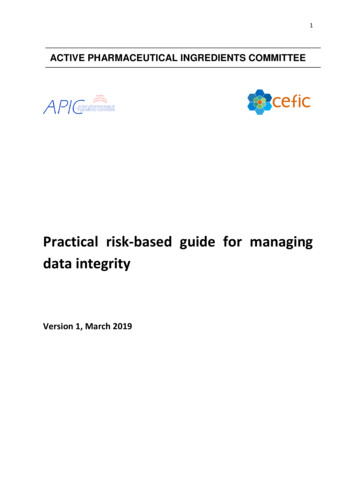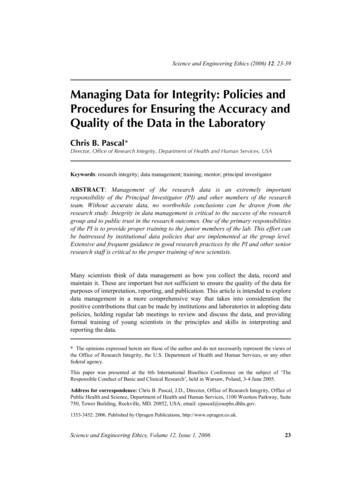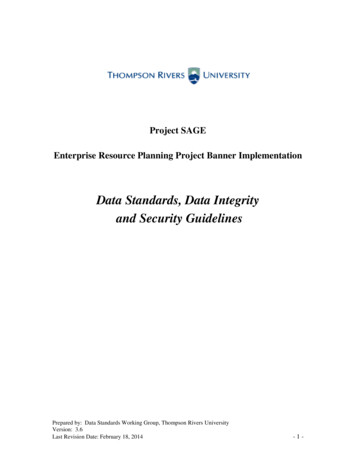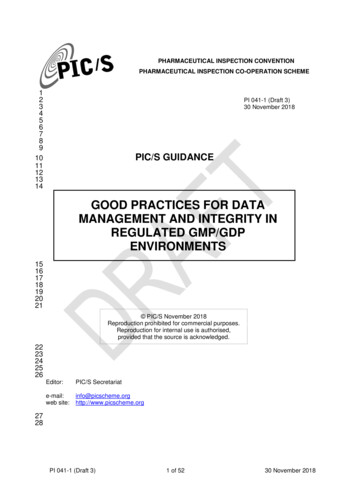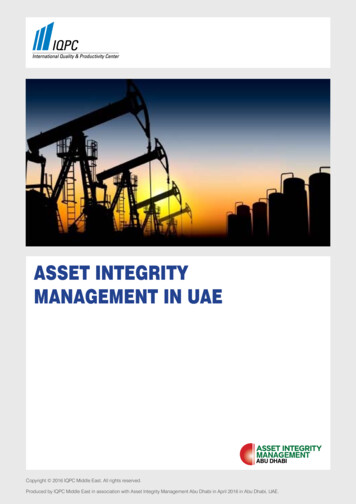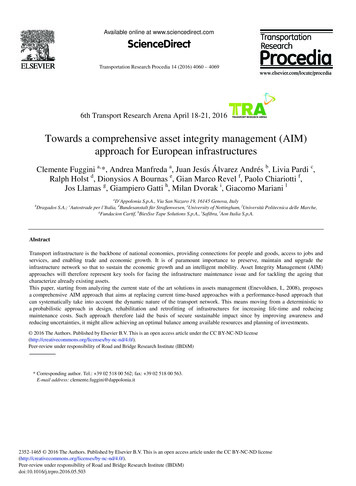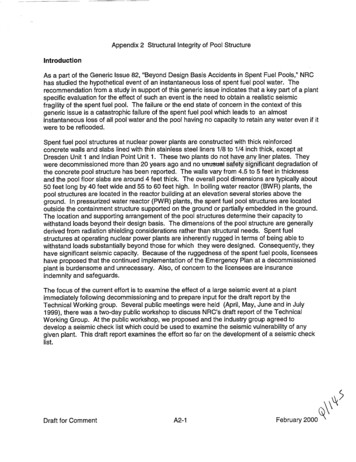
Transcription
Appendix 2 Structural Integrity of Pool StructureIntroductionAs a part of the Generic Issue 82, "Beyond Design Basis Accidents in Spent Fuel Pools," NRChas studied the hypothetical event of an instantaneous loss of spent fuel pool water. Therecommendation from a study in support of this generic issue indicates that a key part of a plantspecific evaluation for the effect of such an event is the need to obtain a realistic seismicfragility of the spent fuel pool. The failure or the end state of concern in the context of thisgeneric issue is a catastrophic failure of the spent fuel pool which leads to an almostinstantaneous loss of all pool water and the pool having no capacity to retain any water even if itwere to be reflooded.Spent fuel pool structures at nuclear power plants are constructed with thick reinforcedconcrete walls and slabs lined with thin stainless steel liners 1/8 to 1/4 inch thick, except atDresden Unit 1 and Indian Point Unit 1. These two plants do not have any liner plates. Theywere decommissioned more than 20 years ago and no unuistual'safety significant degradation ofthe concrete pool structure has been reported. The walls vary from 4.5 to 5 feet in thicknessand the pool floor slabs are around 4 feet thick. The overall pool dimensions are typically about50 feet long by 40 feet wide and 55 to 60 feet high. In boiling water reactor (BWR) plants, thepool structures are located in the reactor building at an elevation several stories above theground. In pressurized water reactor (PWR) plants, the spent fuel pool structures are locatedoutside the containment structure supported on the ground or partially embedded in the ground.The location and supporting arrangement of the pool structures determine their capacity towithstand loads beyond their design basis. The dimensions of the pool structure are generallyderived from radiation shielding considerations rather than structural needs. Spent fuelstructures at operating nuclear power plants are inherently rugged in terms of being able towithstand loads substantially beyond those for which they were designed. Consequently, theyhave significant seismic capacity. Because of the ruggedness of the spent fuel pools, licenseeshave proposed that the continued implementation of the Emergency Plan at a decommissionedplant is burdensome and unnecessary. Also, of concern to the licensees are insuranceindemnity and safeguards.The focus of the current effort is to examine the effect of a large seismic event at a plantimmediately following decommissioning and to prepare input for the draft report by theTechnical Working group. Several public meetings were held (April, May, June and in July1999), there was a two-day public workshop to discuss NRC's draft report of the TechnicalWorking Group. At the public workshop, we proposed and the industry group agreed todevelop a seismic check list which could be used to examine the seismic vulnerability of anygiven plant. This draft report examines the effort so far on the development of a seismic checklist.Draft for CommentA2-1February 2000ý
Available NRC studiesThere are two relevant reports on this issue:1.NUREG/CR 4982, Severe Accidents in Spent Fuel Pools in Support of Generic SafetyIssue 82, Published July 1987.2.NUREG/CR 5176, Seismic Failure and Cask Drop Analyses of the Spent Fuel Pools atTwo Representative Plants, Published January 1989.Subsequent to the completion of work for the above studies, NRC performed a study to reviewthe central and eastern US probabilistic seismic hazard and issued NUREG-1488, RevisedLivermore Seismic Hazard Estimates for 69 Nuclear Power Plant Sites East of the RockyMountains, Published, October 1993. It is well recognized that the LLNL seismic hazard curvesused prior to the publication of NUREG-1488 were overly conservative. In theNUREG/CR-5176 study of the Vermont Yankee plant, the high confidence of low probability offailure (HCLPF) level for the spent fuel pool is 0.5 g and at the H. B. Robinson site the HCLPFvalue is 0.65 g. A comparison of the 1989 and the 1993 LLNL hazard curves shows that theprobabilities of exceeding these values are factors of 2 and 1.6, respectively, higher if the olderand more conservative 1989 study is used.Structural Behavior:Seismic vulnerability of spent fuel pool structures is expected at levels of earthquake groundmotion equal to 2.5 to 3.5 times the plant's safe shutdown earthquake (SSE). These are suchlarge earthquake motions that design basis seismic analyses are not likely to be representativeof the behavior of the pool structure under failure level earthquakes. There is considerabledifficulty in judging the adequacy of simple analytical models. These large earthquake motionswould induce large strain in the foundation medium, the soil structure interaction effect would bemodified and if there was not much rocking motion under the SSE, increased rocking motioncan be expected for large earthquakes. Impact with adjacent buildings cannot be ruled out forthe large seismic event and damage to the pool structure due to the failure of the overheadcrane equipment or the failure of the superstructure would have to be taken into account. Upliftof the pool foundation mat and impact on the subgrade would seek out weak links in the poolstructure and could lead to local spalling of concrete. Amplification of ground motion upthrough the reactor building could be substantially higher than the SSE response for BWR poolstructures. The design, layout and construction of the pool structures are very important toconsider in a seismic vulnerability assessment.The seismic hazards at the west coast sites are generally governed by known active tectonicsources, consequently, the hazard curves have a much steeper slope near the higher groundmotion level. Another way to say this, as the magnitude of the seismic event increases, theprobability of its occurrence goes down rapidly. Thus a seismic event equal to 2.5 to 3.5 SSEat a west coast site may be considered incredible for the site. Therefore, for West coast sites aseismic event greater than 2 times the SSE could be considered to be too large to beincredible. Spent fuel pool structures at these sites would then need to have capacity againstcatastrophic failure at 2 times the SSE.Draft for CommentA2-2February 2000
Structural Failure ModesAmong the various ways a pool structure can fail, the only failure modes that are of concern arethose that involve pool floor slab failure, failure of side walls at the bottom of the pool or at thebottom corners. It is important to ensure that the structural integrity assessment is based onrealistic failure modes for catastrophic loss of structural integrity. This should take into accountphysical interactions with adjacent structures and equipment.For PWR spent fuel pools, the pool floor slab is not likely to fail except through the effect oflocal concrete spalling due to foundation uplift and impact with the subgrade or adjacentstructures. Failure of walls in partially embedded pools is not likely. Bending moment capacityof the pool walls is very much dependent on reinforcing patterns and the walls are generallyreinforced in an orthotropic pattern, such that the resistance in the horizontal and verticaldirections are unequal. The resistance is also unequal between one wall and another wall.This requires a case by case assessment of the pool wall capacity using plant specificinformation.For BWR spent fuel pools, the floor slab, walls and supporting columns and shear walls needscrutiny to determine the critical failure mode. As in the case of PWR spent fuel pools, theeffect of adjacent structures and equipment on structural failure needs to be evaluated.The stainless steel liner plate is used to assure leak-tightness, cracks in the welded seams arenot likely to lead to catastrophic loss of water inventory unless there is a simultaneous massivefailure of the concrete structure.The emphasis here is that spent fuel pool structures not only vary in layout and elevationbetween PWRs and BWRs, they can also vary within each group. The process of realisticassessment of structural capacity of pool structures begins with a methodical consideration oflikely failure modes associated with a catastrophic loss of integrity.The efforts involved in the assessment of seismic capacity of pool structures typically consist ofthe following:Inspect the pool structure and its vicinity and note:physical condition such as cracking and spalling of concrete, signs of leakage or*leaching and separation of pool walls from the grade surface, potential for pipingconnections, either buried under ground or above ground, to fail due to a largeseismic excitation or interaction with adjacent equipment, and cause drainage ofthe pool below the safety level of the pool water,arrangement and layout of supporting columns and shear walls, assessment of*other loads from tributary load areas carried by the supporting structure of thepool, as-built dimensions and mapping of any existing structural cracks,adjacent structures that can impact the pool structure both above and below the grade surface, supporting arrangement for superstructure and crane andpotential for failure of the superstructure and the crane, potential impact fromheavy objects that can drop in the pool structure and the corresponding dropheights.Draft for CommentA2-3February 2000
Seismic capacity assessments of the pool structure typically consist of the following:review existing layout drawings and structural dimensions and reconcile the*differences, if any, between the as-built and as designed information andconsider the effects of structural degradation as appropriate,from design calculations determine the margin to failure and assess the extrapolated multiple of SSE level that the pool structure could survive,determine whether or not design dynamic response analysis including soilstructure interaction effects are still applicable at the capacity level seismicevent, if not, conduct a new analysis using properties of soil at higher strainlevels and reduced stiffness of cracked reinforced concrete,determine the loads from pool structure foundation uplift and from impact of pool structure with adjacent structures during the capacity level seismic event,determine loads from the impact of a spent fuel rack on the pool floor and theside walls and determine the loads from dropping of heavy objects from thecollapse of a superstructure or the overhead crane,determine a list of plausible failure modes; failure of side walls due to the worst*loading from the capacity level earthquake in combination with fluid hydrostaticand sloshing head and dynamic earth pressure as appropriate, failure of the poolfloor slab in flexure and bending due to loads from the masses of water and thespent fuel and racks, local failure by punching shear due to impact betweenstructures and the spent fuel racks or dropping of heavy objects,the assessments to determine the lowest structural capacity can be based on*ultimate strength of reinforced concrete structures due to flexure, shear andpunching shear. When conducting a yield line analysis, differences in flexuralyield capacities for the negative and positive bending moments in two orthogonaldirections influence the crack patterns, and several sets of yield lines may haveto be investigated to obtain the lowest capacity. For heterogeneous materials,the traditional yield line analysis provides upper bound solutions; consequently,considerable skill is needed to determine the structural capacity based on theyield lines that approximate the lower bound capacity.Although the inspection of the pool structure is an essential part of establishing that thestructure is in sound condition, some of the other attributes of a detailed capacity evaluation, asdiscussed above, may only be undertaken for plants that do not pass simple examination usinga seismic check list. Such an effort may be necessary for plants in higher seismic hazard areasalso.Public Meeting of April 13,1999Presentations made by NEI relied on the NRC-sponsored studies and concluded that structuralfailure of the spent fuel pool is not likely, based on probability of the initiating events, and shouldbe eliminated from further consideration in the risk informed decommissioning rule making. NEIarguments are risk based and do not take into account uncertainties associated with theseismic risk which range from 2.4x104 to 3.1x10 1 1 per ry. For this reason, it is important toconduct a seismic vulnerability assessment on a case by case basis and either establish a riskinformed performance goal or develop a simple method of eliminating plants on the basis oftheir seismic robustness.Draft for CommentA2-4February 2000
Other ConsiderationsNRC-sponsored studies have treated the assessment of seismic capacity of spent fuel poolsrelying on the seismic margins method to determine the high confidence of low probability (lessthan 5% failure) of failure (HCLPF). The HCLPF value for a structural failure may well beunrealistic and unnecessarily conservative in terms of an instantaneous loss of water inventory.This point needs to be emphasized because the shear and moment capacity of the walls andslabs are determined by using upper limits of allowable stresses. In the study which resulted inNUREG/CR 4982, the seismic capacities were based on the Oyster Creek Reactor building anda shear wall from the Zion Auxiliary building. For elevated pool structures, the Oyster Creekestimate may be an acceptable approximation, but the Zion shear wall may be a too highlysimplified to substitute for the catastrophic failure of the spent fuel pool structure. However, it isimportant to emphasize that out of plane loading on the pool walls from the hydrostatic head ofthe pool water can lead to flexure and shear induced failures. Relatively low margin onallowable out of plane shear strength combined with the uncertainty of the extent to whichrein
Appendix 2 Structural Integrity of Pool Structure Introduction As a part of the Generic Issue 82, "Beyond Design Basis Accidents in Spent Fuel Pools," NRC has studied the hypothetical event of an instantaneous loss of spent fuel pool water. The recommendation from a study in support of this generic issue indicates that a key part of a plant specific evaluation for the effect of such an event .





